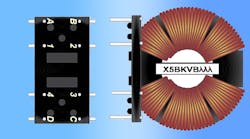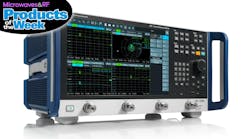Building a Zero-Order BPF with CRLH Transmission Lines (.PDF Download)
Miniaturization of RF/microwave filters helps pave the way to developing smaller wireless devices for internet access. Using metamaterials and circuit structures such as composite-right-left-handed (CRLH) resonators has proven effective in shrinking RF/microwave filter circuits and was demonstrated in the design of a compact bandpass filter (BPF) well-suited for WiMAX wireless applications.
Leveraging third-order coupled CRLH resonators, the filter achieves a center frequency of 5.9 GHz with transmission zero at 6.4 GHz. Measuring just 16 × 24 mm2, or about 40% the size of BPFs based on conventional resonators, the filter has a passband insertion loss of just 1.5 dB.
Metamaterials have shown great promise for the fabrication of compact, high-frequency RF/microwave circuits.1-4 First proposed in 2002, CRLH transmission lines (CRLH-TLs) are forms of high-frequency transmission lines that exhibit backward-wave transmission behavior capable of unusual electromagnetic (EM) wave propagation. Metamaterial approaches to microwave circuit design are typically based on CRLH or negative-refractive-index transmission lines in planar structures by loading a host transmission line with series capacitor and shunt inductive load.
Use of metamaterials and CRLH-TLs enables the design of RF/microwave BPFs with small size, low passband loss, and even low cost. The small sizes supported by metamaterials make possible multiple-band filters that are a fraction of the size of BPFs formed with conventional transmission lines.5-10 Coupled metamaterial resonators have formed compact BPFs.8,10 In addition, compact microwave CRLH gap resonators with high quality factors (Qs) show great promise for forming miniature BPFs.11,12
To demonstrate, by combining high-Q CRLH gap resonators with third-order zeroth-order-resonator (ZOR) coupled resonators, a microwave BPF with extremely compact dimensions was designed and fabricated for WiMAX applications with standard, low-cost circuit materials. The filter was constructed on RT/duroid 6010 circuit material from Rogers Corp. The 1.27-mm-thick circuit material has dielectric constant of 10.8 at 10 GHz in the z-axis (thickness). Commercial electromagnetic (EM) simulation software helped optimize the design, which was characterized using a 50-Ω microstrip feed line and commercial test equipment, notably an RF/microwave vector network analyzer (VNA).
Figure 1 shows an equivalent-circuit model of the CRLH-TL that consists of right-handed inductance (LR), right-handed capacitance (CR), left-handed inductance (LL), and left-handed capacitance (CL). In a practical circuit design, CL is fabricated as a four-finger interdigital capacitor, LL is a viahole in the printed-circuit-board (PCB) material, and capacitance CR and inductance LR are parasitic circuit elements essentially invisible in size.








